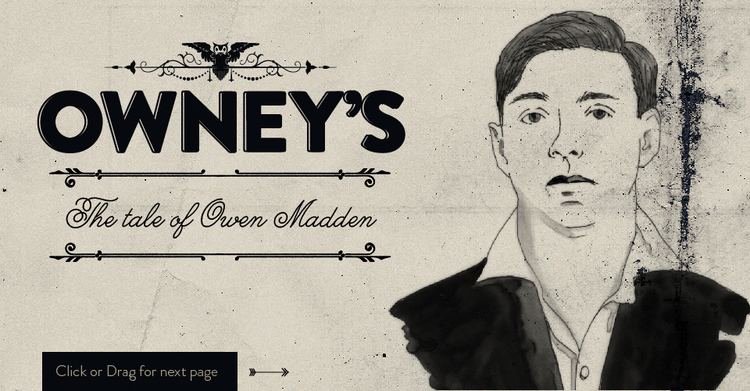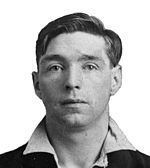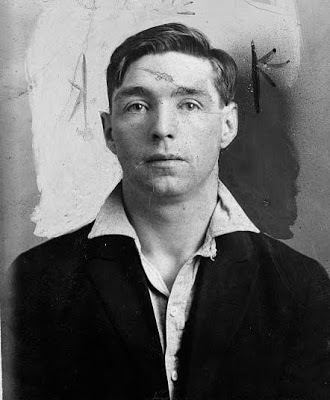Other names The Killer | Name Owney Madden | |
 | ||
Full Name Owen Vincent Madden Similar People Dutch Schultz, Bob Hoskins, Francis Ford Coppola, William Kennedy, Mickey Cohen | ||
hell's kitchen new york documentary Owen The Killer Madden Documentary - Cotton Club Owner British Mobster Owney Madden Biography I put together all
owney madden history day
Owen Vincent Madden, known as Owney Madden and nicknamed "The Killer" (December 18, 1891 – April 24, 1965) was a leading underworld figure in Manhattan, most notable for his involvement in organized crime during Prohibition. He also ran the famous Cotton Club and was a leading boxing promoter in the 1930s.
Contents
- hells kitchen new york documentary Owen The Killer Madden Documentary Cotton Club Owner British Mobster Owney Madden Biography I put together all
- owney madden history day
- Early life
- Gopher Gang
- Prohibition
- The Cotton Club
- Boxing
- Exile in Hot Springs
- In popular culture
- References

Early life

Owen Vincent Madden was born into a working-class family at 25 Somerset Street in Leeds, England on December 18, 1891, the son of Francis Madden and Mary Madden (née O'Neil.)

The story goes that in search of work, the family moved first to Wigan, then to Liverpool, that it was Francis' intention to take the family to the United States, and that he died before this ambition could be fulfilled. However there is strong evidence (newspaper reports, prison registers and criminal records) that Francis Madden alias Francis Summers alias Francis Summers Madden, habitual petty thief and drunkard, remained in Leeds where he died on March 11, 1932.

In 1901, Mary Madden sailed to New York on the RMS Oceanic, to stay with her widowed sister Elizabeth O'Neil, at 352 10th Avenue, in Manhattan. Owen and his older brother, Martin, were left at a children's home, at 36 Springfield Terrace, in Leeds, until 1902, when Mary could finally afford passage for them. The family found a new home in New York's long-established Irish community, which was to shape Madden's life permanently, giving him a reliable and loyal network among the thousands of other Irish emigrant families who had made New York their home.
Gopher Gang

On June 4, 1902, Madden, together with his brother Martin and his younger sister Mary, sailed from Liverpool as steerage passengers on board the SS Teutonic. Settling in New York's Hell's Kitchen, Madden joined the Gopher Gang later that year. Described by associates as "that banty little rooster from hell", Madden quickly became a fierce fighter, known for his skill with a lead pipe and gun in fights with rivals the Hudson Dusters. Madden gained the nickname "the Killer" after gunning down an Italian gang member in the streets, after which he shouted, "I'm Owney Madden, 10th Avenue!" Despite the public nature of the murder, no witnesses came forward linking Madden to the crime.
By 1910, at age 18, Madden had become a prominent member of the Gophers and was suspected in the deaths of five rival gang members. His reputation soon gained him leadership of one of the three factions of the Gophers. He was earning as much as $200 ($2500 in 2016 USD) a day from the Gophers' criminal activities, such as the gang's protection racket which forced local businessmen to pay in the face of firebomb threats.
During this time, Madden enjoyed an opulent lifestyle, and he was often accompanied by several women. However, he became known for his violent jealousy when he shot and killed a store clerk named William Henshaw, who had asked out one of Madden's girls while on board a trolley. Henshaw initially survived the attack and identified Madden as his assailant. When Henshaw later died of his wounds, police arrested Madden. Though the attack had numerous witnesses, the case had to be dismissed after no corroborating witnesses came forward. Over the next three years, the Gophers reached the height of their power as Madden recruited various gunmen into the gang. As Madden began encroaching into rivals' territory, particularly the Hudson Dusters, he was ambushed and shot eleven times outside a 52nd Street dance hall by three members of the Dusters, on November 6, 1912. Madden survived the attack, however, and refused to identify his attackers to police, stating "Nothing doing. The boys'll get 'em. It's nobody's business but mine who put these slugs in me!" Within a week of his release, several members of the Dusters had been killed.
In 1914, Madden became involved in a dispute with Little Patsy Doyle, a prominent member of the Dusters, over a woman named Freda Horner. In a breach of Irish gangland ethics, Doyle informed police of Madden's operations. Following Doyle's assault on Madden's close friend, Tony Romanello, Madden arranged for Doyle's murder. Madden relayed a message to Doyle through Margaret Everdeane (a friend of Freda Horner) to meet him, supposedly in order to reconcile. As Doyle arrived on November 28, 1914, Madden ambushed Doyle and killed him. The police questioned Horner and Everdeane, who both confessed to their roles in the killing. Madden was eventually sentenced to 20 years at Sing Sing Prison in Ossining, New York.
Prohibition
After serving nine years of his sentence, Madden was released on parole in 1923. The Gopher gang had broken up, and many members of his own faction were either in Sing Sing or working for bootlegging gangs.
Upon his release he was given a job by an old friend, a former member of Madden's street gang who had moved up to better things. Larry Fay had a sharp mind for crime. However, he was not the most physically imposing of gangsters and he needed Madden's muscle to help establish the taxi business he had set up from profits he had made running Canadian whisky across the border during the early days of Prohibition. Fay employed a gang of strong-arm men to help him gain control of the most profitable cab-stands along Broadway and Madden became their leader. Later Fay also became involved in New York's milk trade, attempting to turn its delivery into a racket. Owney Madden learned quickly and soon moved on to form his own organization.
During this time, Madden employed a young friend as a personal driver. The driver, George Raft, later became a film star noted for his authentic portrayals of gangland figures.
Fay had used Prohibition as a means to raise money for other ventures, but Madden saw it as too good an opportunity to pass up, and soon became heavily involved in bootlegging, establishing a territory in the Hells Kitchen area. In 1924 the Madden gang began highjacking liquor shipments belonging to Big Bill Dwyer; but rather than go to war, Dwyer took Madden on as a partner when Dwyer decided he needed to beef up the enforcement side of his own operations.
The Cotton Club
Madden and his former gang rival turned partner, Big Frenchy De Mange (George Fox DeMange), began to open or acquire some of the flashiest speakeasies and nightclubs of the era, most notably the legendary Cotton Club.
Madden purchased the Club Deluxe from former Heavyweight Boxing Champion Jack Johnson and reopened it a year later. Nightclub patrons flooded into Harlem from downtown Manhattan to catch performers such as Cab Calloway, Duke Ellington, Louis Armstrong, Lena Horne, Bill "Bojangles" Robinson and the Nicholas Brothers. Madden and his partners, Big Bill and Big Frenchy, also muscled their way into a piece of the exclusive Stork Club, where the influential gossip columnist Walter Winchell held court and everyone who was anyone wanted to see and be seen. As a celebrity nightclub owner with ownership in more than twenty clubs, Madden became well-known and glamorized for his Prohibition-era activities. He also gained recognition for his revenge tactics and payoffs of City Hall.
Boxing
In 1931, shortly before the end of Prohibition, Madden got out of bootlegging and entered into partnership with boxing promoters, "Broadway" Bill Duffy and George Jean "Big Frenchie" DeMange. Between them, they controlled the careers of several boxing champions including Max Baer and Primo Carnera. As Carnera's manager, Madden arranged fixed fights which led eventually to Carnera's winning the NBA World Heavyweight Championship, in 1933. Carnera held onto the title for nearly a year, until reporters' suspicions about fixed fights led Madden to desert the Italian strongman, setting up Carnera's famous defeat at the hands of Baer on June 14, 1934.
Exile in Hot Springs
In 1932, Madden was involved in the murder of Vincent "Mad Dog" Coll, who had been extorting money from several mobsters, including DeMange and Madden. After being arrested for a parole violation that same year, Madden began facing greater harassment from police and encroachment on his territory by Italian Mafia families, until he finally left Manhattan, New York City in 1935.
Leaving behind racketeering, Madden settled in Hot Springs, Arkansas which had become known as a haven for various criminals, with a corrupt city government and police force. He also became involved in local criminal activities, especially illegal gambling. The Southern Club became a popular nightspot for mobsters; Charles Luciano was apprehended there in 1935. Madden became a naturalized U.S. citizen in 1943, and eventually married the daughter of the city postmaster. He lived in Hot Springs until his death in 1965.
